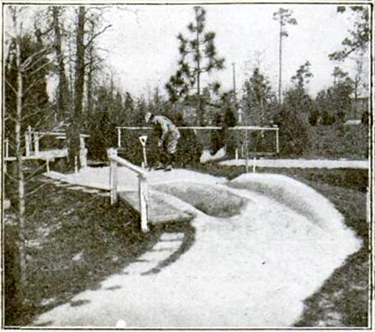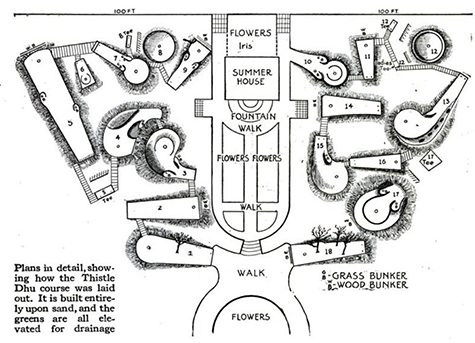
North Carolina is not only "First in Flight," but also first in the flight of fancy that is miniature golf. The tiny courses now covering not only the United States but the world were born in the state. Although earlier examples of what was called "garden" or "lawn" golf appeared in the United Kingdom, it wasn't until 1919 when James Wells Barber completed construction of a course on his Pinehurst estate in Moore County that the game most Americans would recognize today as miniature golf came into being.
Born in 1852, Mr. Barber was himself an Englishman but emigrated in 1887 to the United States to manage Barber and Co., the shipping empire he and his brother had built. An avid golfer, Barber, like many of his contemporary captains of industry, chose to spend time in chic Pinehurst, home of one of America's premier golfing resorts.
Becoming a substantial investor in the growth of the developing community, in 1917 he began construction on his second Pinehurst residence. There, he contracted with another enthusiastic golfer and amateur architect, Edward H. Wiswell, to design a miniature course in the garden of his estate for the entertainment of guests. This Wiswell did and upon looking at the completed garden, either Barber or Wiswell (the record here is in dispute), uttered, "This'll do." The words stuck and the home, the miniature course, and one of the holes upon it, all took on the name "Thistle Dhu", a supposedly Scottish articulation of the phrase.
Mr. Barber had not intended on creating a new pastime. He and his designer considered his garden to hold a golf course -- albeit a small one. The eighteen-hole Thistle Dhu course was built for experienced golfers. It was certainly not for children. A story in the May 1921 edition of Golf Illustrated relates how a golfer named Tom Kelley "in a recent tournament over Thistle Dhu ... failed in twenty-two attempts …" on a single hole. Moreover, the holes on Thistle Dhu such as "Sandy Hook" and "Bunker Hill" were named, not surprisingly, using the language of golf. Luminaries of the larger game were fascinated by it. Glenna Collett, still considered one of golf's greats, called it "a lovely course." What sets it apart most from miniature courses developed later was the requirement on four of Thistle Dhu's holes that the player use a "niblick" (what would today be considered a nine iron) to make the tee shot. In fact, when Barber's estate was put up for sale, the attached course was described as a "pitch and putt 18 hole golf."

Still, for the first time, all the elements of miniature golf were there. Thistle Dhu's scale was right. The longest hole was only seventy-one feet; the shortest, a mere twelve. Rather than the traditional grass, the putting surfaces were made of compacted and architecturally drained sand. Each of the holes could supposedly be made in a single shot. Besides natural impediments, artificial structures such as mounds of concrete (a favorite material of miniatures to come) were positioned to obstruct the progress of the ball. The tiny greens were rimmed with bricks, and rules for penalty shots, should your ball exit the green, applied. The course contained a fountain, little walkways, shrubs and flowers as innumerable future courses would.
Thistle Dhu remained a private course throughout its existence. Write-ups and photographs in magazines and newspapers made it known to the public -- a public that was soon to go wild for a new game called miniature golf. It is impossible to know how much impact these pictures and articles had on thousands of courses created during the miniature golf craze that overtook America in the 1920s and 30s, but Barber and Wiswell's celebrated creation clearly had significant influence.
In 2012, the Pinehurst Resort opened a new putting course on its famous grounds. They named it "Thistle Dhu."